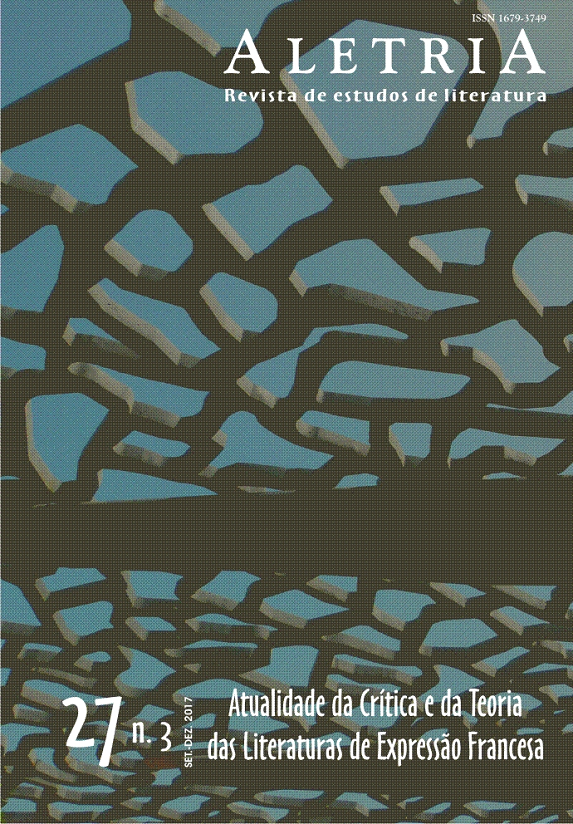Imagens de caça na Ars amatoria ovidiana
DOI:
https://doi.org/10.17851/2317-2096.27.3.237-256Palabras clave:
poesia didática, caça, narrativa, mito, metáfora, OvídioResumen
Neste artigo, desejamos focar-nos na incorporação de assuntos de caça à Arte de amar, de Ovídio. Embora a obra se concentre na descrição de eventos e personagens, sobretudo, inseridos em ambientação urbana, devido a seus muitos contatos com a tradição da elegia erótica romana, decerto encontramos o emprego de muitas imagens agrícolas ou venatórias no interior do poema. Sobre o emprego de imagens de caça na Ars, diferenciamos aquelas vezes em que elas se ligam a relatos míticos e aquelas em que tal sobreposição não ocorre. No último caso, tende a haver metaforização dessas imagens, mas no outro não, o que aproximaria a linguagem dos trechos mítico-venatórios de Arte de amar do emprego denotativo da linguagem.
Descargas
Citas
AYMARD, Jacques. Les chasses romaines: des origines à la fin du siècle des Antonins. Paris: E. de Boccard Éditeur, 1951.
AZEVEDO, Sarah Fernandes Lino. As ideias de ordem e desordem imperiais relacionadas às leis matrimoniais de Augusto: uma análise sob a ótica das relações de gênero. Mare Nostrum, São Paulo, v. 5, n. 5, p. 44-58, 2014.
CARCOPINO, Jérôme. La vie quotidienne à Rome dans l’apogée de l’Empire. Paris: Pluriel, 2011.
COELHO, Ana Lucia Santos. Sexualidade e poder: os ensinamentos amorosos de Ovídio em confronto com a ordem visual da Vrbs de Augusto. Métis: História & Cultura, Caxias do Sul, v. 13, n. 26, p. 77-99, jul./dez. 2014.
CHARPIN, François. Le féminin exclu: essai sur le désir des hommes et des femmes dans la littérature latine. Paris: Calepinus; Michel de Maule, 2001.
DAY, Archibald A. The Origins of Latin Love Elegy. Oxford: Basil Blackwell, 1938.
GIANGRANDE, Giuseppe. Topoi ellenistici nell’Ars amatoria. In: GALLO, Italo; NICASTRI, Luciano (Org.). Cultura poesia ideologia nell’opera di Ovidio. Napoli: Edizioni Scientifiche Italiane, 1991. p. 61-98.
GRATTIUS. Cynegetica. In: PUBLILIUS SYRUS et alii. Minor Latin Poets. Tradução de J. Wight Duff and Arnold M. Duff. Cambridge, Mass.; London: England, 1982. v. 1, p. 143-208.
GREEN, C. M. C. Terms of Venery: “Ars Amatoria” I. Transactions of the American Philological Association, Baltimore, v. 126, p. 221-263, 1996. doi: https://doi.org/10.2307/370178
GRIMAL, Pierre. Dictionnaire de la mythologie grecque et romaine. Paris: Presses Universitaires de France, 1963.
HOLZBERG, Niklas. Ovid: the poet and his work. Tradução de G. M. Goshgarian. Ithaca: Cornell University Press, 2002.
HUNTER, R. L. A Comédia Nova da Grécia e de Roma. Tradução de Rodrigo Tadeu Gonçalves et al. Curitiba: UFPR, 2010.
LABATE, Mario. L’arte di farsi amare: modelli culturali e progetto didascalico nell’elegia ovidiana. Pisa: Giardini, 1984.
LEACH, Eleanor Winsor. Georgic Imagery in the “Ars amatoria”. Transactions and Proceedings of the American Philological Association, Baltimore, v. 95, p. 142-154, 1964.
MOCANU, Alin. Hunting in Seneca’s “Phaedra”. Past Imperfect, Alberta, v. 18, p. 27-52, 2012.
OVÍDIO. Arte de amar. Tradução, introdução e notas de Matheus Trevizam. Campinas: Mercado de Letras, 2016.
OVÍDIO. Primeiro livro dos “Amores”. Tradução de L. A. de Bem. São Paulo: Hedra, 2010.
PROPÉRCIO. Elegias de Sexto Propércio. Tradução, organização, introdução e notas de G. Gontijo Flores. Belo Horizonte: Autêntica, 2014.
TOOHEY, Peter. Epic lessons: an introduction to ancient didactic poetry. London; New York: Routledge, 1996.
VEYNE, Paul. A elegia erótica romana. Tradução de Mariana Echalar. São Paulo: UNESP, 2015.
WHITLATCH, Lisa A. The Hunt for Knowledge: Hunting in Latin Didactic Poets. 2013. 183 f. Thesis (Doctorate in Philosophy) – Graduate School-New Brunswick, New Brunswick, New Jersey, 2013.
Descargas
Archivos adicionales
Publicado
Cómo citar
Número
Sección
Licencia
Derechos de autor 2017 Matheus Trevizam (Autor)

Esta obra está bajo una licencia internacional Creative Commons Atribución 4.0.
Authors who publish with this journal agree to the following terms:Authors retain copyright and grant the journal right of first publication with the work simultaneously licensed under a Creative Commons Attribution Non-Commercial No Derivatives License that allows others to share the work with an acknowledgement of the work's authorship and initial publication in this journal.Authors are able to enter into separate, additional contractual arrangements for the non-exclusive distribution of the journal's published version of the work (e.g., post it to an institutional repository or publish it in a book), with an acknowledgement of its initial publication in this journal.Authors are permitted and encouraged to post their work online (e.g., in institutional repositories or on their website) prior to and during the submission process, as it can lead to productive exchanges, as well as earlier and greater citation of published work (See The Effect of Open Access).





